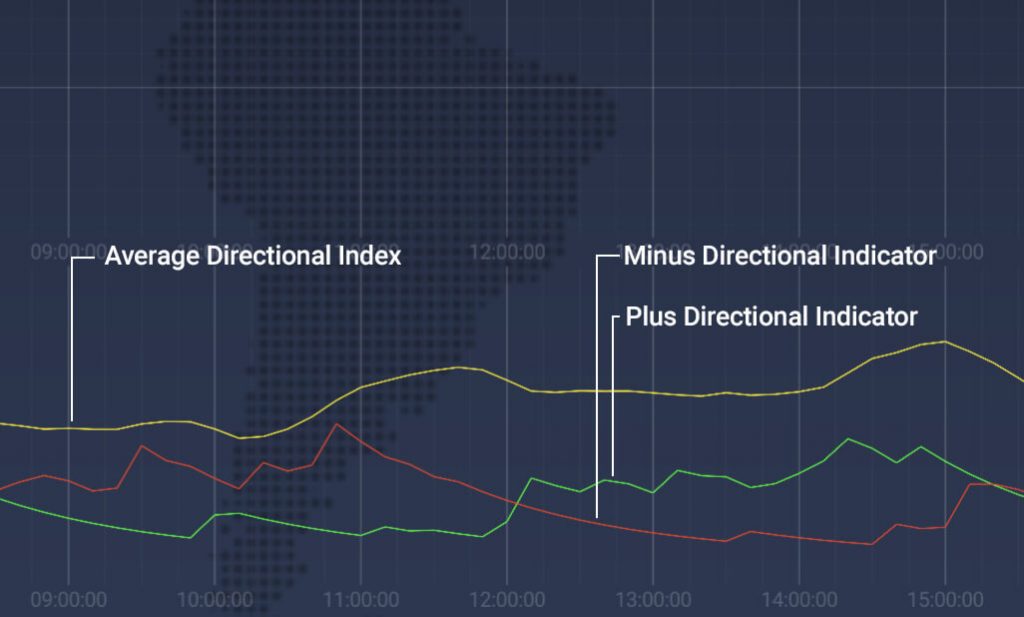How to Use ADX (Average Directional Index) in Forex

![]()
Average Directional Index or ADX Indicator referred to as a “market strength indicator.” ADX indicator invented by J. Welles Wilder. Pioneer in technical analysis who also devised the Relative Strength Index Indicator, the Parabolic SAR, and many other indicators. ADX is a technical analysis tool that traders may use to gain a better read on the broader market.
What is Average Directional Index (ADX) in Forex
It is a mix of two other indicators. Negative and the Positive Directional Indicator are supplementary indicators which indicate the trend is bullish or bearish. Trends deemed strong when they exceed 25. Weak when they go below the critical threshold.
Because trend is weak doesn’t mean that prices won’t rise or decrease. It means the market hasn’t decided on clear direction or is too volatile.
Why the Average Directional Index (ADX)Indicator Matters
If forex market start ADX is used to Analysis whether the Market is trending or ranging. In absence of trend the tool can help traders to make more consistent money by determining trading methods.

These tool is one of the pillars of technical analysis and one of few prominent tools established by financial analyst wizard and author J. Welles Wilder that are still in use today. Wilder’s book New Concepts in Technical Trading Systems is well-known.
In 1980s, Forbes Magazine dubbed him the “champion” technical trader, Who built reputation for devising “more accurate commodities trading techniques .”
With proper market analysis, trading can be profitable. Our market analysis section contains predicts and reviews: technical, expert outlooks, and fundamental analysis. The data compiled by Milliva the best forex broker in India will keep you updated. Always travel with the market trends.
What Is the Average Directional Index (ADX) Indicator and How Does It Work?
1.Negative and the Positive Directional Indicator, abbreviated as +DI and -DI
2. Positive Directional Indicator is to Analysis uptrend +DI is heading upwards. It indicates that an uptrend is becoming stronger.
3.Negative Directional Indicator is to determine the downturn. If the -DI is going downwards, it means that the decline is becoming stronger.
4.This Two indicators can be seen separately and most typically seen on stock charts. When the two lines cross, traders might receive buy or sell signals.
Average Directional Index (ADX) Indicator is Calculated us Follows.
The Average Directional Index calculation and average directional index formula are among the most sophisticated of all technical analysis.
1.The formula to find +DM and –DM
2.UpMove = today’s high − yesterday’s high
3.DownMove = yesterday’s low − today’s low
4.if UpMove > DownMove and UpMove > 0, then +DM = UpMove, else +DM = 0
5.if DownMove > UpMove and DownMove > 0, then -DM = DownMove, else -DM = 0
After that, you must choose the number of periods, which are usually 14 by default. Traders can customize the indicator’s parameters to meet their own requirements.
To find +DI and -DI : +DI = 100 times the smoothed moving average of (+DM) divided by average true range -DI = 100 times the smoothed moving average of (-DM) divided by average true range
ADX = 100 times the smoothed moving average of the absolute value of (+DI -DI) divided by (+DI + -DI) is the last calculation to determine the ADX formula.

What Is the Average Directional Index Indicator and How Do I Read It?
The tool becomes reasonably straightforward to comprehend if you grasp what the ADX indicator is and what it accomplishes. It offers additional signals on whether an asset is a buy or a sell.
ADX and the two directional movement indicators are combined, they may not only assist signal when a trend is changing from bearish to bullish, but they can also help quantify the trend’s strength.
What Is the Average Directional Index Indicator and How Do I Use It?
Its advantage might be a quick method to earn, but you must first grasp how to utilize it. Weak trend is indicated by readings below 20 or 25. Whilst readings above this indicate a trend is strengthening.
Values between 75 and 75 indicate a rise in trend strength. Whilst readings over 75 indicate that a trader should get out of a position.
Meanwhile, each Directional Index may be used to indicate whether a trend is strengthening or weakening, as well as to provide buy or sell signals based on whether the lines cross over
The Best Trading Strategies for Average Directional Indexes
Many elite traders’ arsenals include ADX generates enormous sums of profit for those that employ it on a regular basis. When the ADX indicator shows a value of above 25, it indicates that a trend is strong and likely to persist. ADX crossed above 25 buy signal will be sent. It resulted in significant gains when the uptrend persisted over the following weeks.
As the Strength of the Trend Increases
The same is true for sale signals as it is for buy ones. A signal is provided if the ADX for a downtrending market breaks over 25. The ADX is over 25 in the sample below, indicating that TRY is slipping into a steep decline vs JPY. From there, the tendency just became stronger, eventually leading to a catastrophic drop.
With a Directional Index Crossover
Strong Uptrends for a Long Time When +DI and ADX Both Push Up
Crossovers of the +DI and -DI produce buy or sell signals, as we already know. However, when the +DI increases or falls, it indicates that a trend is gaining traction. When the two lines crossover and broaden, it might lead to extremely strong buy signals when the ADX rises over 25.
Find all about No Trade Zones. When the Markets Are Fluctuating
When a trend is missing, the ADX might signal that the market is likely to chop and range. Traders might change their trading techniques or wait for a breakout to enter a position at this time.
Filtering False Readings Using ADX and Parabolic SAR
Because the ADXR, and specifically each Directional Index, can occasionally produce misleading signals, combining the indicator with additional tools like the Parabolic SAR can assist to filter out the erroneous readings and deliver more conservative indications.
Traders’ Tips and Common Mistakes
Using the ADX to identify bullish or bearish trends is one of the most common blunders traders make. Traders must instead rely on the two directional indices and the data they give.
ADX, like many other lagging indicators, can provide false positives.
Understanding the tool’s limits, as well as integrating it with other indicators like the Relative Strength Index, Parabolic SAR, and others, is critical. This might assist traders corroborate the signals provided by the ADX and adopt a more cautious approach to trading.
Milliva the best forex broker in India provides MetaTrader 5 which offers a robust trading system with market depth and separate orders and trades accounting system in the Best Forex Platform In World. It also supports two order accounting systems: the traditional web and hedging option systems. There are four order execution methods to meet different trading objectives: spot, demand, market, and exchange execution. It offers comprehensive price analysis, algorithmic trading applications (trading robots, expert advisors), and great tools for copy trading.







djst org
05th Apr 2022Outstanding story there. What happened after? Good luck!
How to calculate Average Directional Index (ADX) in Forex
01st Sep 2022[…] directional index to be a very useful indicator, and it has become one of the most often utilized technical analysis tools available. It is one of the most accurate trend strength indicators, and it has assisted many […]